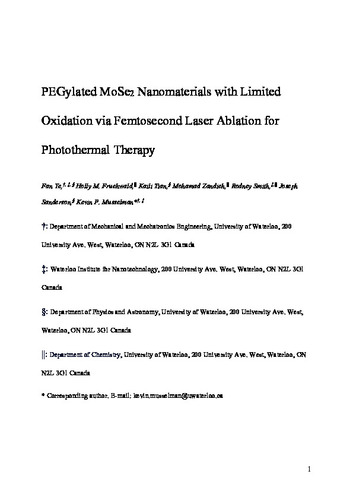| dc.contributor.author | Ye, Fan | |
| dc.contributor.author | Fruehwald, Holly M. | |
| dc.contributor.author | TIAN, KAILI | |
| dc.contributor.author | Zandieh, Mohamad | |
| dc.contributor.author | Smith, Rodney | |
| dc.contributor.author | Sanderson, Joseph | |
| dc.contributor.author | Musselman, Kevin P. | |
| dc.date.accessioned | 2024-02-23 21:21:15 (GMT) | |
| dc.date.available | 2024-02-23 21:21:15 (GMT) | |
| dc.date.issued | 2024 | |
| dc.identifier.uri | https://doi.org/10.1021/acsanm.3c04865 | |
| dc.identifier.uri | http://hdl.handle.net/10012/20368 | |
| dc.description | This document is the Accepted Manuscript version of a Published Work that appeared in final form in ACS Applied Nano Material, copyright © 2024 American Chemical Society after peer review and technical editing by publisher. To access the final edited and published work see https://doi.org/10.1021/acsanm.3c04865 | en |
| dc.description.abstract | MoSe2 nanomaterials are promising photothermal agents for non-invasive cancer treatment. Their surfaces usually need to be functionalized with biocompatible polymers to improve their biocompatibility and colloidal stability and to reduce their cytotoxicity. Herein PEGylated MoSe2 nanomaterials are produced by femtosecond laser ablation of MoSe2 powder in aqueous polyethylene glycol (PEG) solutions. Quantum dots are produced by laser ablation for 30 min with a power of 1.5 W, while larger spherical nanoparticles are produced by laser ablation for 10 min with various powers. PEG molecules attach to the nanomaterials through both physical absorption and Mo-O chemical bonds. A higher concentration of PEG in the solution results in more PEG being attached and increasing the laser ablation power leads to more PEG molecules being attached through chemical bonds. Notably, the attachment of PEG to the nanomaterials through Mo-O bonds can efficiently suppress the oxidation of the MoSe2 nanomaterials to MoO3 nanoparticles. Both the MoSe2 quantum dots and spherical nanoparticles demonstrate high photothermal conversion efficiencies (PTCEs) and the PTCEs of the quantum dots are overall higher than those of the nanoparticles, making them a promising candidate agent for photothermal cancer therapy. | en |
| dc.description.sponsorship | New Frontiers in Research Fund Exploration Program, NFRFE-2018-2018-00630. | en |
| dc.language.iso | en | en |
| dc.publisher | American Chemical Society | en |
| dc.relation.ispartofseries | ACS Applied Nano Materials;7(1) | |
| dc.subject | pulsed laser ablation | en |
| dc.subject | photothermal | en |
| dc.subject | laser-matter interaction | en |
| dc.subject | in-situ functionalization | en |
| dc.subject | oxidation suppression | en |
| dc.subject | polyethylene glycol | en |
| dc.subject | molybdenum selenide | en |
| dc.title | PEGylated MoSe2 Nanomaterials with Limited Oxidation via Femtosecond Laser Ablation for Photothermal Therapy | en |
| dc.type | Article | en |
| dcterms.bibliographicCitation | Ye, F., Fruehwald, H. M., Tian, K., Zandieh, M., Smith, R., Sanderson, J., & Musselman, K. P. (2023). Pegylated Mose2 Nanomaterials with limited oxidation via femtosecond laser ablation for photothermal therapy. ACS Applied Nano Materials, 7(1), 736–745. https://doi.org/10.1021/acsanm.3c04865 | en |
| uws.contributor.affiliation1 | Faculty of Engineering | en |
| uws.contributor.affiliation2 | Mechanical and Mechatronics Engineering | en |
| uws.typeOfResource | Text | en |
| uws.peerReviewStatus | Reviewed | en |
| uws.scholarLevel | Graduate | en |

